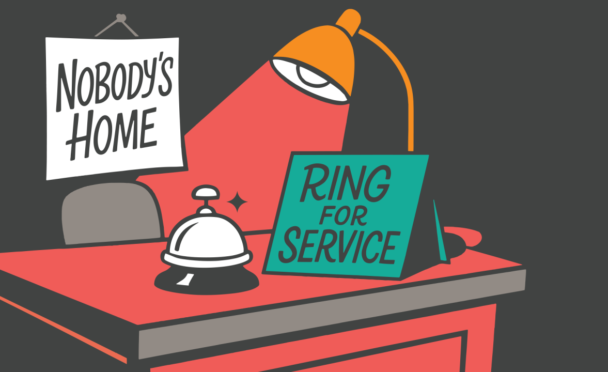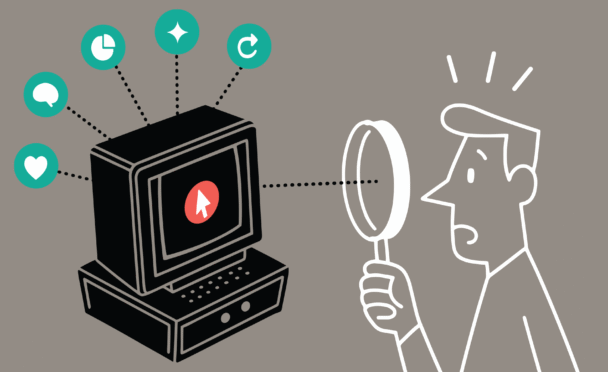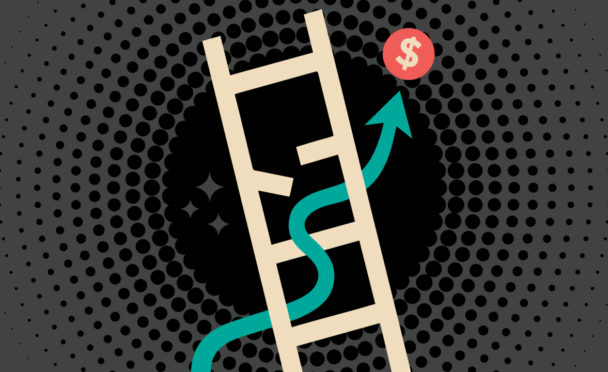Helpful or hollow? Why every financial services message needs to prove its worth
A few weeks ago I added an employee card to one of my business credit card accounts. It was easy and seamless. Several days later my team member received the physical card in the mail with instructions on how to activate it. As is standard, there were a few options given, including doing it through …
Staying on target: Using team reviews to keep financial services campaigns lean and impactful
Financial services marketing has no shortage of moving parts—features to promote, compliance hurdles to clear, and internal voices that all want to be heard. Without discipline, campaigns balloon into clutter. That’s why we think internal agency team reviews are a critical component of the creative process. Not only do they open opportunities for cross-discipline collaboration, …
Making every texture count: why thoughtful tactile decisions are key to successful collateral
I remember working on a direct mail kit for a financial services Client during the time of Covid. No way we could be in the room with them to present the thinking, and also no way a flat screen or PDF was going to tell the story we needed to tell. So we packaged up …
Aligning ‘Earth, Moon, Galaxy’ concepts with your strategic objectives—every time
All marketers know this: there’s almost always more than one way to achieve your marketing goals. The challenge is adeptly exploring what’s possible, and home in on a range of ideas that are on strategy, and provide different ways of meeting the goals. That’s why when financial services brands ask us to create major initiatives …
Clickthroughs are a trap
Way back in 1995 I helped launch the first website I ever worked on, for The Wall music stores. (Music stores? Just how old am I??). And honestly from that day until now, thirty years later, I cannot tell you how many times I’ve been in conversation with Clients and the key metric identified for …
Cut Through the Noise: Using Competitive Research to Stay Aligned with Your True Objectives
Using competitive research to cut through the noise Financial services has a volume problem: too many messages, not enough meaning. It’s why the category is rife with creative that is virtually indistinguishable from one brand to another. That’s exactly why you need to start by doing competitive research. It’s an opening move—not a rescue mission—that …
Cut the Clutter: How Real‑Size Mockups Keep Your Direct Mail Clear and On‑Target
Imagine you’re working on a direct mail kit for your financial services product. You’ve done all the hard work and it’s looking awesome on screen—great colors, clean layouts. You’re feeling good about your choices. You ship it to the printer, and in (fairly) short order it’s out making its way to your prospect via USPS. …
Are you sure about that? Challenge assumptions to keep your financial services marketing on point.
Financial‑services marketing is crowded with trends, inherited wisdom, and pressure to “do what everyone else is doing.” The result? Campaigns that look alike, sound alike, and fail to move the metrics that actually matter. The antidote is simple but demanding: ruthlessly challenge assumptions, and do it at the beginning of the work. Why assumptions creep …
Prototyping with purpose: Ensuring every interaction supports your marketing goals
There’s nothing more expensive than building something nobody needs. And in financial services—where complexity is high, trust is fragile, and teams often move fast—it’s dangerously easy to ship experiences that look polished, but don’t actually move the needle. That’s why purposeful prototyping isn’t just a UX best practice. It’s a strategic tool. Done right, prototyping …
Want to design truly helpful experiences? Use digital expectation research to eliminate friction
Speed still matters, but it no longer wins the day on its own. Today’s benchmark is helpfulness—the feeling that an experience understands what you’re trying to do and clears a straight path to getting it done. Our way of finding that path is something we call digital‑expectation research: a ruthlessly focused look at how real people glide …
Zero in on what matters: How personas drive more effective campaigns
If you’ve ever sat in a strategy meeting debating whether to go all-in on TikTok, launch another email flow, or test a new OOH concept, you’ve likely run into the same issue: too many options, not enough clarity. That’s where a solid persona strategy changes the game. A well-built persona is a strategic tool that …
Streamlining large projects with laser focused stakeholder interviews
Big initiatives stall for simple reasons: unclear goals, competing priorities, and unspoken assumptions that turn a straight sprint into a maze of detours. That’s why, early in every engagement, we schedule ruthlessly focused stakeholder interviews—one‑on‑one conversations designed to surface nuance, encourage candor, and align decision‑makers before any heavy lifting begins. Why big projects stumble Even the …
Focusing on what truly counts: Turning a bold vision into meaningful results
“Data that says something ‘works’ is only valid under the exact circumstances in which it was tested. Which means you’ve optimized yourself into a pinhole view of what you think works.” I remember my partner, Shannon Stevens, saying this to a Client and it stopping them in their tracks. Shannon was completely right – in …
Using responsive briefs to make it actually brief
Most engagements start with a traditional creative brief from the Client. Too often it’s a sprawling PDF stuffed with legacy slides, buried KPIs, and five different “number‑one” objectives. Helpful intent—bloated execution. Why it matters: According to our 2024 Finsights study, 75% of consumers say they’re dissatisfied with their current financial‑services provider—a clear warning that indifference …
Why Your Application Flow Might Be Costing You Customers (And What to Do About It)
Let’s be honest: the way most financial brands handle digital applications still feels like it’s built for 2005. You know the drill—long forms, irrelevant fields, weird questions too early in the process, and the dreaded “submission error” screen that sends your potential customer straight to a competitor. Here’s the truth: Your onboarding experience isn’t a …
Beyond the obvious: how our “3 reasons why” framework challenges complacency in financial services creative
Three concise “reasons why this works” for every idea. That’s what we come prepared with when we present thinking to our Clients—clear, focused statements that anchor the conversation around why we believe a concept works. Not three customer‑facing claims—three internal reasons why we believe the idea earns its place in the room. It’s a forcing …
Confidence Is the New Currency: Why Financial Brands Must Kill the Status Quo
If your customer walks away from your marketing more confused than when they started, you don’t have a messaging problem—you have a trust problem. Financial services is already complex. If your communications, product flows, or onboarding experiences don’t simplify that reality, you’re not empowering people—you’re overwhelming them. And overwhelmed people don’t buy. They bail. Confidence …
Breaking the clickthrough obsession: why financial brands need a broader measure of success
Clickthrough rates aren’t meaningless. But they’re wildly overvalued. We see it all the time in financial services: Clients show us a piece of creative that performs well because it “gets clicks”—even if those clicks come from the wrong audience, lead nowhere meaningful, or fade out before anyone takes real action. It’s the illusion of effectiveness. …
Designing with Empathy: Why Helpful UX Builds the Trust Financial Brands Desperately Need
When was the last time a financial product’s marketing actually helped you? Not just worked. Not just “converted” you to a customer. But made you feel understood, or more confident. If you’re drawing a blank, you’re not alone. Despite being one of the most trust-dependent industries on the planet, financial services often forget the most …
Live team reviews: how collaborative feedback challenges complacency in financial services campaigns
At Shiny, creative reviews aren’t a solo exercise. We meet live, as a team, because strategy-driven creative work demands more than just feedback—it demands discussion. We don’t just review each other’s work. We challenge it. We ask better questions. We wordsmith together. We interrogate assumptions. We ruthlessly obsess over clarity, tone, and the ‘why’ behind …
Staying on target: Using team reviews to keep financial services campaigns lean and impactful
Financial services marketing has no shortage of moving parts—features to promote, compliance hurdles to clear, and internal voices that all want to be heard. Without discipline, campaigns balloon into clutter. That’s why we think internal agency team reviews are a critical component of the creative process. Not only do they open opportunities for cross-discipline collaboration, …
Aligning ‘Earth, Moon, Galaxy’ concepts with your strategic objectives—every time
All marketers know this: there’s almost always more than one way to achieve your marketing goals. The challenge is adeptly exploring what’s possible, and home in on a range of ideas that are on strategy, and provide different ways of meeting the goals. That’s why when financial services brands ask us to create major initiatives …
Cut Through the Noise: Using Competitive Research to Stay Aligned with Your True Objectives
Using competitive research to cut through the noise Financial services has a volume problem: too many messages, not enough meaning. It’s why the category is rife with creative that is virtually indistinguishable from one brand to another. That’s exactly why you need to start by doing competitive research. It’s an opening move—not a rescue mission—that …
Are you sure about that? Challenge assumptions to keep your financial services marketing on point.
Financial‑services marketing is crowded with trends, inherited wisdom, and pressure to “do what everyone else is doing.” The result? Campaigns that look alike, sound alike, and fail to move the metrics that actually matter. The antidote is simple but demanding: ruthlessly challenge assumptions, and do it at the beginning of the work. Why assumptions creep …
Want to design truly helpful experiences? Use digital expectation research to eliminate friction
Speed still matters, but it no longer wins the day on its own. Today’s benchmark is helpfulness—the feeling that an experience understands what you’re trying to do and clears a straight path to getting it done. Our way of finding that path is something we call digital‑expectation research: a ruthlessly focused look at how real people glide …
Streamlining large projects with laser focused stakeholder interviews
Big initiatives stall for simple reasons: unclear goals, competing priorities, and unspoken assumptions that turn a straight sprint into a maze of detours. That’s why, early in every engagement, we schedule ruthlessly focused stakeholder interviews—one‑on‑one conversations designed to surface nuance, encourage candor, and align decision‑makers before any heavy lifting begins. Why big projects stumble Even the …
Using responsive briefs to make it actually brief
Most engagements start with a traditional creative brief from the Client. Too often it’s a sprawling PDF stuffed with legacy slides, buried KPIs, and five different “number‑one” objectives. Helpful intent—bloated execution. Why it matters: According to our 2024 Finsights study, 75% of consumers say they’re dissatisfied with their current financial‑services provider—a clear warning that indifference …
Beyond the obvious: how our “3 reasons why” framework challenges complacency in financial services creative
Three concise “reasons why this works” for every idea. That’s what we come prepared with when we present thinking to our Clients—clear, focused statements that anchor the conversation around why we believe a concept works. Not three customer‑facing claims—three internal reasons why we believe the idea earns its place in the room. It’s a forcing …
Breaking the clickthrough obsession: why financial brands need a broader measure of success
Clickthrough rates aren’t meaningless. But they’re wildly overvalued. We see it all the time in financial services: Clients show us a piece of creative that performs well because it “gets clicks”—even if those clicks come from the wrong audience, lead nowhere meaningful, or fade out before anyone takes real action. It’s the illusion of effectiveness. …
Live team reviews: how collaborative feedback challenges complacency in financial services campaigns
At Shiny, creative reviews aren’t a solo exercise. We meet live, as a team, because strategy-driven creative work demands more than just feedback—it demands discussion. We don’t just review each other’s work. We challenge it. We ask better questions. We wordsmith together. We interrogate assumptions. We ruthlessly obsess over clarity, tone, and the ‘why’ behind …
What matters to you?
Want to get work that really matters for you and your business? Let’s talk.
Email Us


















